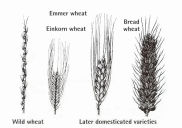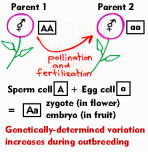Арсланова_Г_А_и_др_Essential_English_for_Biology_Students (1). Kazan federal university
 Скачать 7.01 Mb. Скачать 7.01 Mb.
|
Text 6.3. Artificial Selection■ Essential targets: By the end of this text you should be able to: describe one example of artificial selection; distinguish between inbreeding and outbreeding; explain the meaning of hybrid vigour. Pre-reading ■ In a small group discuss the current problems associated with the artificial selection and then try and answer the following questions: How do you understand artificial selection? Do you have any ideas about how wheat cultivation began? Can you explain the difference between inbreeding and outbreeding? ■ Read the given text and make your essential assignments: T  he cultivation of wheat Ever since farming began in the Middle East about 10 000 years ago, humans have been breeding animals and plants selectively to produce specific desirable qualities. Wheat was probably among the first crop to be cultivated. By selective breeding over thousands of generations, wild wheat has been converted into the modern types which produce much higher yields. In selective breeding, particular individuals are chosen and allowed to breed, whereas others are prevented from breeding. This means that alleles that give characteristics favoured by humans are retained, while those that give undesirable characteristics are eliminated. Artificial selection is therefore similar to directional selection, in that selection pressure brings about a gradual change in the genotype of a group of organisms. However, in artificial selection it is humans, not environmental factors, that act as the selection pressure, gradually bringing about changes in allele frequencies. We can only speculate as to how wheat cultivation began. Perhaps people who gathered wild seeds for food observed that seeds spilled accidentally sprouted new plants from which more seeds could be harvested. This might have encouraged them to save some seeds to sow for the following season’s crop. Wild wheat sheds its grains as soon as they are ripe. This makes harvesting difficult. Therefore, grains were most likely to be gathered from plants that by chance retained their grains a little longer. By using this grain for the next crop, farmers would inadvertently have started the process of selective breeding. The next stage in the cultivation of wheat would have been the deliberate selection of varieties with desirable qualities. Early farmers appear to have selected grains from plants which gave the greatest yield, and produced grain which was easy to separate from its husk. Eventually, over many generations, the variety of cultivated wheat changed. This led to the ancestor of our modern wheat, in which the grains are held so firmly that they must be removed by a separate operation after harvest. Selective breeding of wheat continues today by a combination of inbreeding and outbreeding. Inbreeding involves breeding between closely related individuals which by chance, possess some desirable character. In wheat, desirable characters include: high yield short stem length (allowing the plant to devote more energy to the production of seeds, which have a much higher value than straw from stems) pest resistance (for example, to fungal moulds and rusts) high protein content of the grain. Inbreeding is carried out to try and retain the desirable characters in future generations. Wheat plants are particularly suitable for selective breeding because they self pollinate naturally. They are unlikely to cross fertilise without the intervention of the plant breeder. Inbreeding allows a farmer to produce a uniform crop which is easy to harvest and has, given certain conditions, predictable characters. However, this uniformity of characters is at the expense of genetic diversity may be reduced to such an extent that every individual has identical alleles (a condition known as complete homozygosity). Such a wheat strain cannot be changed because there are no other alleles present that could produce genetically different plants. Another problem is that if genetically identical plants are exposed to new diseases to which the plants have no resistance, all the plants may be killed. S O  utbreeding involves crossing individuals from genetically distinct strains. The offspring from such a cross are called hybrids. If the parental stocks are pure breeding, the offspring are called F1 hybrids. F1 hybrids often have characters, such as grain yield in wheat, which are superior to the characters in either parent. This phenomenon is called hybrid vigour or heterosis. Hybrid vigour probably results from an increased heterozygosity arising from the mixing of alleles. Harmful recessive alleles are less likely to be present in the homozygous condition. Hybrid vigour is also thought to result from some form of interaction between particular combinations of alleles in the hybrid. Whatever the explanation of hybrid vigour, if the descendants of F1 hybrids are continually inbred, the vigour decreases as the plant become more homozygous again. Outbreeding depends on the availability of genetically distinct animals and plants. It is therefore important to maintain sources of genetic diversity. This may be done by maintaining seed banks of old or wild varieties of plants (the genetic diversity of wheat, rice, cabbages, and carrots is maintained in this way). Also, adults of old varieties of animals and plants with little or no commercial value may be maintained as a source of new alleles for future breeding programmes. ■ Glossary of essential terms for you to know:
■ Your Essential Assignments I. Quick check: 1. Which type of natural selection does artificial selection resemble? 2. What effect does: a) inbreeding; b) outbreeding have on the genetic diversity of a population? 3. Give two possible explanations of hybrid vigour in plants produced by a cross between two different strains of pure-breeding plants. II. Fill in the missing words:
III. Use monolingual English dictionary and write down what could the words given below mean: breeding, desirable, seed, cultivation, stem, crop. IV. Match these words with their definitions:
V. Find English equivalents to the following word combinations:
VI. Give Russian equivalents to the following English terms:
VII. Find synonyms among the pool of words:
VIII. Answer the following questions. Use all information given before: How long have humans been breeding animals and plants selectively to produce specific desirable qualities? 2. What does selective breeding mean? 3. What type of natural selection is artificial selection similar to? 4. Describe how wheat cultivation began. 5. What does inbreeding involve? 6. Why is inbreeding carried out? 7. What does outbreeding involve? 8. How is the offspring from outbreeding called? 9. What is called hybrid vigour? IX. Match the sentence halves. Make complete sentences:
X. Read and translate the short text without any dictionary: Fact of life: With the advent of genetic engineering. Artificial selection has entered a new phase. It is now possible to breed clones of cattle and sheep which have genes for producing specific human proteins. What is more, nuclei of two different species can be combined to form a completely new type of animal. In this way, a hybrid that combines the characters of a sheep and a goat has been formed: this new species has been dubbed a “geep” by the popular press. Plants can also genetically engineered to incorporate characters of a number of different species, for example, potatoes with a high starch content and high productivity can be genetically engineered to produce the beta-carotene of green vegetables and the vitamins of citrus fruits. One day it might be possible to design foods on a computer by choosing characteristics from a palette of tastes, colours, textures, and nutrients. XI. Food for thought: The dog is thought to have been the first domesticated animal. For at least 12 000 years, it has been subjected to artificial selection. Dogs have been bred to do specific types of work (for example, Labrador retrievers for retrieving fishing gear, Old English sheepdogs for rounding up sheep, and poodles for retrieving ducks) or for show. Suggest why pedigree dogs bred for show tend to have more genetic disorders than mongrels and cross-breeds (for example, highly inbred pedigree Labradors often have hip problems, St Bernards suffer eye problems, and Pekineses pften have respiratory problems). |
